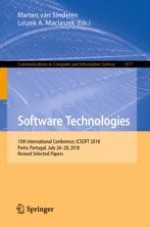2019 | OriginalPaper | Chapter
Can Commit Change History Reveal Potential Fault Prone Classes? A Study on GitHub Repositories
Authors : Chun Yong Chong, Sai Peck Lee
Published in: Software Technologies
Publisher: Springer International Publishing
Activate our intelligent search to find suitable subject content or patents.
Select sections of text to find matching patents with Artificial Intelligence. powered by
Select sections of text to find additional relevant content using AI-assisted search. powered by
